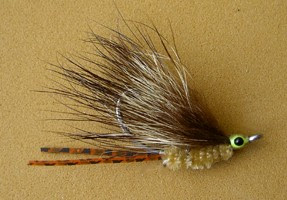The Clouser Minnow has been beaten to death by just about every blog and printed publication out there. People tie them on jig hooks, with yak hair, craft fur....you name it. Evolution is a good thing, but I'd like to discuss some small adjustments that increase durability and performance of this amazing pattern.
I have been rereading Bob Clouser's books.
Clouser's Flies and
Fly Fishing for Smallmouth in Rivers and Streams and have been inspired <again>. This pattern is a proven winner on the water and in the vise. In my opinion the key is in it's simplicity. Aside from the eyes this pattern is made up of some bucktail and flash. If you haven't tried your hand at a Clouser Deep Minnow hopefully this post will help you get started! God know this pattern catches fish....all of them.
Too Much Hair!
The first few times you tie a Clouser you inevitably tie on too much bucktail. I made that mistake and many of you have too! Here is an example of a Clouser I tied a few years back. They are totally fishable, but in my opinion I tied on too much hair
 |
| The Black/White Clouser is good....The rest are too bulky |
Keep them on the sparse side if you can. Resist the urge to pack it on the shank.
Watch the Eye
I also struggled with the eye placement on Clouser Minnows for months. Often times I tied in the hourglass eyes too close to the eye of the hook leaving little space for the head. Improper placement of the weighted eye causes the buck tail to splay upward, more perpendicular to the hook shank. You are going for a slender bait fish profile, not a bait fish with a mo-hawk.
 |
| Good eye placement - Head too close to the hourglass eye |
Placement of the eye on the hook shank also greatly impacts the swimming action of this pattern. Too close to the front and the fly is now a jig. Too far back and it looses it's front dipping action that often times initiates strikes.
The Hook
The solution to the hook/hourglass eye problem is actually simple. If you have access to popper hooks your eye placement woes are cured! The Mustad 33903 Kink Shank popper hook is the key to perfect proportions when it comes to Clouser Minnows. The kink in the hook shank creates a nest for the hourglass eye - helping keep perfect proportions. Another added benefit is the eye stays in place better in the kink.
 |
| Mustad 33903 Popper Hook |
 |
| Nest for the bead chain or dumb bell eye |
The Mustad 33903 was a real breakthrough for me to create consistent Clouser Minnows. Best of all this hook relatively inexpensive! Check out
Captain Hook's Discount Warehouse for this hook as well as the Mustad 3366 - another classic bass hook.
Wrapping the Belly
Art Scheck author of
Tying Better Flies adds a nice detail to Clouser Minnows that increases durability of the pattern. Bob Clouser lashes the belly of the fly to the shank with spiral wraps. Those spiral wrap can fray when bouncing off rocks and branches. Art uses a red thread to create a gill spot on the lower portion of the Clouser. This gill spot is coated with head cement to create a reinforced anchor that is far more durable than spiral wraps. Mr Scheck's technique not only makes the pattern last longer, it adds a nice detail.
 |
| Nice tie, but look closely at the spiral wraps on the belly |
 |
| Spiral wraps |
 |
| Art Scheck's reinforced gill wrap |
Junk in the Trunk
Richard A. Lewis published a great Clouser article on The Fly Anglers Online about tying Clouser Clones. Richard's article stresses the importance of extending the flash material past the tail of the fly by at least 1/2". Here is what Mr. Lewis had to say:
"Extending the flash materials beyond the winging materials will enhance this fly's undulating action. Of course it also adds additional reflected prismatic light to this already attractive and deadly fly. The extended flash tail is a straightforward addition to the Clouser Deep Minnow. Dan Blanton is responsible for the innovation of the "Flash Tail Clouser" modification as well as other "FT" enhanced flies. The "Flash Tail" upgrade, if you will, improves the action and fish catching prowess of the Clouser so much that Bob Clouser himself now advocates the incorporation of the "FT" into his Clouser Deep Minnow pattern and credits Dan for this improvement to the pattern."
 |
| Long Flash |
The Clouser shown above is a fine example of a nicely tied Clouser. Notice the length of the flash and how is comes back farther than the buck tail. The "Flash Tail" is a definite upgrade to the Clouser Deep Minnow.
It's hard to believe that the Clouser Minnow can become more productive and more durable. Guys like Art Scheck, Dan Blanton and Richard Lewis have helped to refine this pattern. I hope you find these adjustments helpful.
Many of the images in this post are from Richard Lewis's article
Tying Deep Minnow Clones on the Fly Anglers Online. Art Scheck's feedback is also linked in the article.
 |
| Smallmouth Fly Box Flash Tail Half and Half |
























































